Short Run Economic Fluctuations
1/48
There's no tags or description
Looks like no tags are added yet.
Name | Mastery | Learn | Test | Matching | Spaced |
|---|
No study sessions yet.
49 Terms
potential output
the maximum output when an economy is reaching productive & allocative efficiency (full employment)
also called trend growth
actual output
fluctuates around potential output
→ short run economic fluctuations influence actual output
sticky prices
tendency of prices to remain constant/adjust slowly
flexible prices
prices that change and adjust more quickly than sticky prices
inflation rate
the percentage change in prices in a given time period
core inflation rate
eliminates volatile prices such as food and energy from the CPI
doesn’t fluctuate as much as it only includes the sticky prices of goods & services
better indicator
CPI
decompose CPI graph to obtain sticky and flexible price inflation graphs
fluctuations in the US inflation rate
1970s = OPEC oil, cost-push inflation
1992-2008 2% inflation target - called average price level targeting
Atlanta Fed
published their inflation analysis of sticky and flexible price inflation to eliminate noise and get a better ideas of the direction of travel of inflation
weighting?
when they use monetary policy tools they’ve put a greater emphasis on sticky prices unlike the UK and give sticky prices a 90:10 weighting in their decision
this is because flexible prices are quite misleading for central bank decision makers
what do firms set prices based on?
expected inflation
output
supply shocks
how does people’s expectations of inflation shape future inflation?
if high inflation is expected, individuals don’t delay purchases as it’s relatively cheaper now → demand pull inflation
rational consumers bring forward spending which creates self-fulfilling inflation
firms then adjust their nominal prices to maintain the same relative price (price of your goods relative to competitor prices)
modelling expected inflation
the expected inflation rate 𝛑^e will be the actual inflation rate 𝛑
as AD increases, there is greater demand for factor inputs into the production process and so costs rise, firms don’t absorb this due to the profit margin and so results in selling prices increasing

what determines expected inflation?
rational expectations
adaptive expectations
rational expectations
assume that inflationary expectations are the best possible forecasts based on all public information
eg actions & statements of the central bank
adaptive expectations
assume expectations are based on past inflation
modelling adaptive expectations
assume expected inflation equals the previous year’s inflation 𝛑(-1)
forecasting that inflation will equal past inflation is an easy shortcut relative to the time-consuming job of forecasting inflation based on all available information

the effect of output on firm’s pricing
in booms firms face increased marginal costs to increase output, which raises prices faster than usual
in recessions firms reduce production which reduces marginal costs and diminishing price increases
adding the effect of output, inflation equals expected inflation when output is at potential
when output rises above potential, inflation rises above expected inflation and vice versa
modelling the Phillips Curve
𝛑(-1) = adaptive expectations
α = how responsive prices are to changes in AD (larger = more sensitive) → affects stickiness of prices
Y = output gap

what does the Phillips Curve show?
shows the short run relationship between output & inflation
output & unemployment Phillips Curves are related through Okun’s Law (relationship that output has on unemployment levels in the economy)
shows that during an economic boom inflation rises and a recession reduces it
Phillips loop in the UK - first part
1967-79:
oil price shock doesn’t follow trend
stagflation
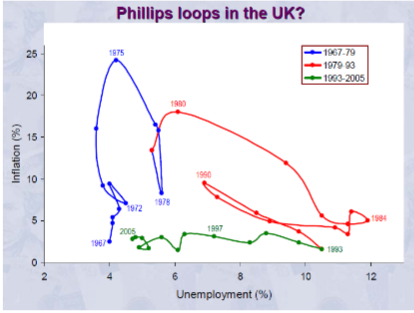
Phillips loop - second part
1992-2008:
great moderation/stability during the inflation targeting period
horizontal Phillips Curve

Phillips loop - third part
1992 onward:
flat curve due to it being the era of globalisation
UK joined EU and other trading blocs
became far more integrated and connected in the global economy
more free trade meant not resource constrained
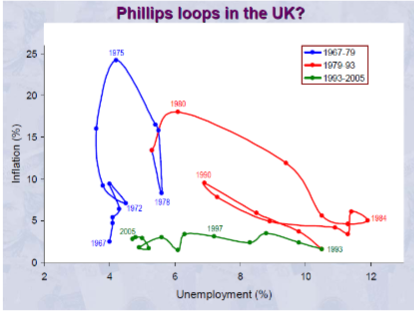
supply shocks
an event that causes a major change in firms’ production costs which in turn causes a short run change in the inflation rate
denoted v
adverse supply shock
raises costs while a beneficial supply shock reduces them
what causes supply shocks?
caused by changes in raw material prices such as oil
caused by a jump in wages due to labour contracts
caused by exchange rate changes that change import prices
including supply shocks in the Phillips Curve
if there is no shock v = 0
if v = 2% eg the shock increases inflation by 2%

adaptive expectations version of Phillips Curve
shows that changes in inflation occur if there is an output gap or a supply shock

aggregate expenditure determinants
C = purchase of goods & services by individuals
I = purchases of physical capital
G = government expenditure on goods & services of their employees
NX = exports minus imports

role of r in determining aggregate expenditure
real interest rate r = the nominal rate minus expected inflation
affects AE since an increase in r reduces AE and vice versa
shift in monetary policy - effect of higher r on spending
consumption: encourages saving, lowers demand especially spending for durable goods
investment: more expensive to finance investment projects
net exports: reduces capital outflows, appreciates real er (SPICED) makes exports expensive to foreign consumers and imports cheaper for domestic consumers → reduces NX
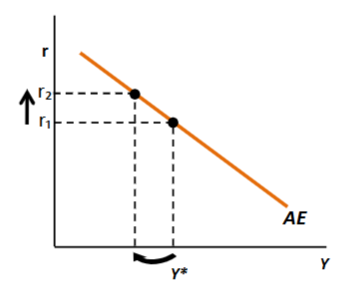
factors that cause positive expenditure shocks
outward shift of AE:
government spending on military
tax cuts
improved consumer confidence
new technology increases investment

how does this affect r?
if the central bank holds the real interest rate constant, equilibrium output rises from a level below potential to a level above potential
factors that cause negative expenditure shocks
inward shift of AE:
changes in bank lending may cause a credit crunch, reducing consumption
foreign business cycles affect other countries through demand for imports/exports
how does this affect r?
if the central bank holds the real interest rate constant, equilibrium output falls from a level above potential to a level below potentialcou
countercyclical monetary policy
output starts at potential and a positive/negative expenditure shock occurs
AE curve shifts but the central bank adjusts the real interest rate to keep output constant
→ lowers r to offset a negative expenditure shock
→ raises r to offset a positive shock
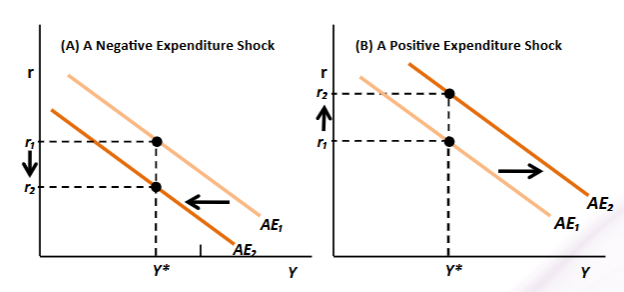
example of countercyclical monetary policy
Federal Reserve lowered its target federal funds rate from 5.25% in August 2007 to almost 0 in December 2008 to increase output
→ proved inadequate to return output to potential
rise in r
starting at potential output and expected inflation, assume an increase in r from r1 to r2
→ higher r pushes output below potential
→ this then pushes inflation below expected inflation (𝛑^e)
→ policymakers can reduce inflation by raising r but at the cost of reduced output in the short run
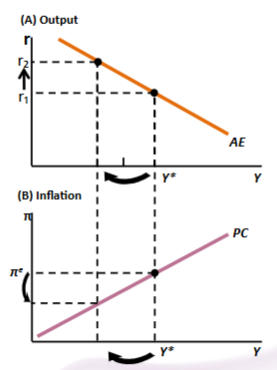
accommodative monetary policy
decision by the central bank to keep the real interest rate constant when a supply shock occurs, allowing inflation to change
nonaccommodative monetary policy
decision by the central bank to adjust the real interest rate to offset a supply shock and keep inflation constant
accommodative monetary policy & expenditure shock
output initially at potential
expenditure shock shifts AE curve outward
central banks uses accommodative monetary policy and hols r constant
output rises above potential
this causes inflation to be pushed above expected inflation
vice versa with adverse supply shock
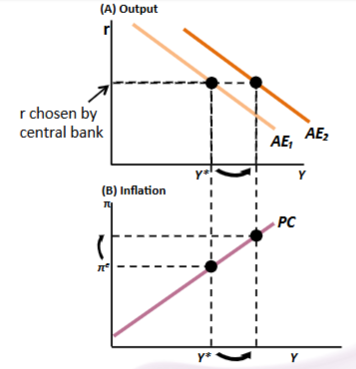
adverse supply shock with accommodative monetary policy
adverse supply shock causes Phillips Curve to shift upward
here central bank uses accommodative policy so output remains constant
with constant output the Phillips Curve raises inflation above expected inflation
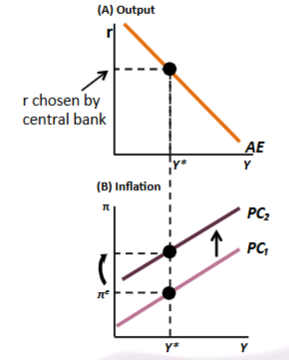
adverse supply shock with nonaccommodative monetary policy
to keep inflation at expected inflation, output must fall
respond to the adverse supply shock by raising the real interest rate
this reduces output which offsets shift in PC, keeping inflation at expected level
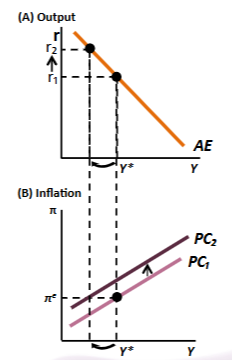
effects of accommodative monetary policy
allows a supply shock to raise inflation permanently even after the shock ends since the positive change in inflation increases the level of inflation into the future
effects of nonaccommodative monetary policy
keeps inflation constant and the fall in output is temporary as only a temporary increase in the interest rate is needed to keep inflation constant
long run monetary neutrality
principle that monetary policy cannot permanently affect real variables (variables adjusted for inflation)
→ long-run unemployment is independent of monetary policy
what are the types of long-run unemployment?
cyclical, demand deficient unemployment
→ these exist at the natural rate when output is at potential and so are independent of monetary policy
how can monetary policy create permanent change?
the only permanent effect of monetary policy is to change inflation and nominal values
→ monetary policy can affect actual output (Y) but not potential output (Y*)
effects of a permanent boom?
attempting to create a permanent boom in the economy (where output is above potential) is inflationary
→ continuous situation of rising inflation by stimulating the economy through low r, QE
→ ultimately continuous inflation is adverse for an economy in the long run as accelerating inflation forces the central bank to change its policy, causing wider economic problems concerning labour mobility and functioning of the economy